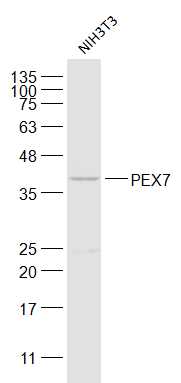
Rabbit Anti-PEX7 antibody
PBD9B; PCDP1; Peroxin 7; Peroxin-7; Peroxisomal PTS2 receptor; Peroxisomal targeting signal 2 receptor; Peroxisome biogenesis factor 7; Peroxisome targeting signal 2 receptor; PEX7; PEX7 protein; PEX7_HUMAN; PTS2 receptor; PTS2R; RCDP1; RD.
View History [Clear]
Details
Product Name PEX7 Chinese Name 过氧化物酶体生成蛋白7抗体 Alias PBD9B; PCDP1; Peroxin 7; Peroxin-7; Peroxisomal PTS2 receptor; Peroxisomal targeting signal 2 receptor; Peroxisome biogenesis factor 7; Peroxisome targeting signal 2 receptor; PEX7; PEX7 protein; PEX7_HUMAN; PTS2 receptor; PTS2R; RCDP1; RD. Research Area Cell biology Neurobiology Signal transduction Immunogen Species Rabbit Clonality Polyclonal React Species Mouse, (predicted: Human, Rat, Dog, Pig, Cow, Horse, Rabbit, Sheep, ) Applications WB=1:500-2000 ELISA=1:5000-10000 IHC-P=1:100-500 IHC-F=1:100-500 ICC=1:100-500 IF=1:100-500 (Paraffin sections need antigen repair)
not yet tested in other applications.
optimal dilutions/concentrations should be determined by the end user.Theoretical molecular weight 36kDa Cellular localization cytoplasmic Form Liquid Concentration 1mg/ml immunogen KLH conjugated synthetic peptide derived from human PEX7: 61-160/323 Lsotype IgG Purification affinity purified by Protein A Buffer Solution 0.01M TBS(pH7.4) with 1% BSA, 0.03% Proclin300 and 50% Glycerol. Storage Shipped at 4℃. Store at -20 °C for one year. Avoid repeated freeze/thaw cycles. Attention This product as supplied is intended for research use only, not for use in human, therapeutic or diagnostic applications. PubMed PubMed Product Detail This gene encodes the cytosolic receptor for the set of peroxisomal matrix enzymes targeted to the organelle by the peroxisome targeting signal 2 (PTS2). Defects in this gene cause peroxisome biogenesis disorders (PBDs), which are characterized by multiple defects in peroxisome function. There are at least 14 complementation groups for PBDs, with more than one phenotype being observed in cases falling into particular complementation groups. Although the clinical features of PBD patients vary, cells from all PBD patients exhibit a defect in the import of one or more classes of peroxisomal matrix proteins into the organelle. Defects in this gene have been associated with PBD complementation group 11 (PBD-CG11) disorders, rhizomelic chondrodysplasia punctata type 1 (RCDP1), and Refsum disease (RD). [provided by RefSeq, Oct 2008]
Function:
Binds to the N-terminal PTS2-type peroxisomal targeting signal and plays an essential role in peroxisomal protein import.
Subunit:
nteracts with PEX5.
Subcellular Location:
Peroxisome. Cytoplasm.
Tissue Specificity:
Ubiquitous. Highest expression in pancreas, skeletal muscle and heart.
DISEASE:
Defects in PEX7 are the cause of peroxisome biogenesis disorder complementation group 11 (PBD-CG11) [MIM:614879]. PBD refers to a group of peroxisomal disorders arising from a failure of protein import into the peroxisomal membrane or matrix. The PBD group is comprised of four disorders: Zellweger syndrome (ZWS), neonatal adrenoleukodystrophy (NALD), infantile Refsum disease (IRD), and classical rhizomelic chondrodysplasia punctata (RCDP). ZWS, NALD and IRD are distinct from RCDP and constitute a clinical continuum of overlapping phenotypes known as the Zellweger spectrum. The PBD group is genetically heterogeneous with at least 13 distinct genetic groups as concluded from complementation studies. Defects in PEX7 are the cause of rhizomelic chondrodysplasia punctata type 1 (RCDP1) [MIM:215100]. RCDP1 is characterized by rhizomelic shortening of femur and humerus, vertebral disorders, cataract, cutaneous lesions and severe mental retardation.
Defects in PEX7 are the cause of peroxisome biogenesis disorder 9B (PBD9B) [MIM:614879]. A peroxisome biogenesis disorder with unusually mild clinical and biochemical manifestations. Affected individuals manifest a variable phenotype similar to, and in some cases indistinguishable from, classic Refsum disease. Variable features include ocular abnormalities, sensorimotor neuropathy, ichthyosis, deafness, chondrodysplasia punctata without rhizomelia or growth failure.
Similarity:
Belongs to the WD repeat peroxin-7 family.
Contains 6 WD repeats.
SWISS:
O00628
Gene ID:
5191
Database links:Entrez Gene: 5191 Human
Entrez Gene: 18634 Mouse
Omim: 601757 Human
SwissProt: O00628 Human
SwissProt: P97865 Mouse
Unigene: 280932 Human
Unigene: 338363 Mouse
Product Picture
Bought notes(bought amounts latest0)
No one bought this product
User Comment(Total0User Comment Num)
- No comment



 +86 571 56623320
+86 571 56623320
 +86 18668110335
+86 18668110335

